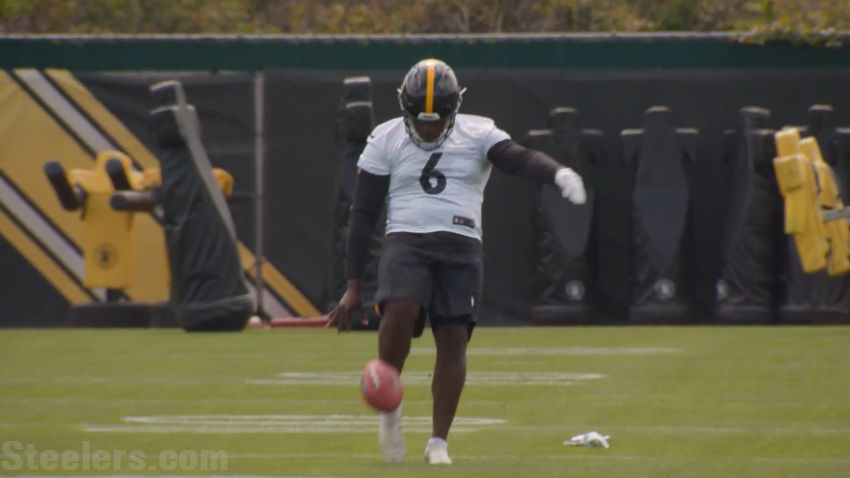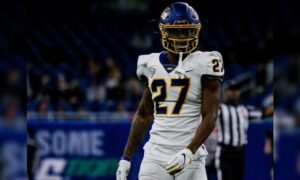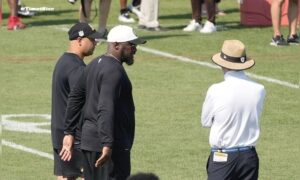With the 254th overall pick in the 2021 NFL Draft, the Pittsburgh Steelers selected Georgia Tech punter Pressley Harvin III. Harvin and the Steelers’ other eight picks could be packaged up into one quick, overall grade. But why not take a detailed look at each individual pick from a number of different viewpoints, before determining a final grade for the player, and later on the entire class?
I designed this exercise to look at and give letter grades based on six specific ways to view the pick (listed below), before taking all that analysis and combining it into a final letter grade. Those five viewpoints comprise much of what goes into the draft grades consumed by so many every year after the draft.
Team Need: Does the player fill a weaker spot on the roster?
Team Fit: Does this player and his skillset fit what the team likes to do offensively and defensively?
Immediate Contributor: Will the player be able to play a big role as a rookie?
Long-Term Contributor: Will the player be a significant part of the team’s future in some capacity?
Pick Value: Did the team reach on this player? Did they pick up a steal who should have gone earlier?
Other Options: Who were the other players still on the board at that selection, both overall and at that specific position?
Overall Grade: A final mark to denote whether the selection was an overall positive one, or one that could’ve been better spent elsewhere.
Each factor doesn’t apply evenly to every pick made. For example, teams expect immediate contributions from a first round selection, while a seventh-rounder is fortunate to just make the roster.
Some factors do, though. Whether picked first overall or 259th, there will always be other options on the board to compare the player to, and steals and reaches can come from any place in the draft.
Round 7, Pick 27: Pressley Harvin III, P, Georgia Tech
TEAM NEED: A
Punting has been an area Pittsburgh has consistently sought improvement at over the last decade. Since a promising career for Daniel Sepulveda ended following injuries, Pittsburgh has cycled through Drew Butler, Mat McBriar, Brad Wing, Dustin Colquitt and Jordan Berry. Berry remains after being cut and brought back last season, and has set the team’s record for punting average the last two seasons. Even doing that, he was below the league average, and the Steelers felt the need to spend a draft pick on competition, the only punter selected in the draft.
TEAM FIT: B+
It’s not as difficult to evaluate team fit for a punter or kicker. Harvin can boom the ball, leading FBS in punting average last season, and that is much of what Pittsburgh is searching for in a potential replacement for Berry. And though it has been talked about way more than it should be given how rare it actually happens, Harvin is more than capable of throwing a quality pass on any fake punt attempts. Harvin’s need to improve consistency as a punter is a slight knock, given how it has been a problem of prior Steeler punters during this last stretch.
IMMEDIATE CONTRIBUTOR: A+
This is a very simple all-or-nothing grade. If Harvin doesn’t win the punting job, he either sits on the practice squad all season or is cut outright, and is a draft pick who never contributes to the Steelers. If he wins the job, he holds it all season and becomes the hopeful solution for the team. Teams don’t spend draft picks on kickers or punters only to cut them before the season begins. As long as Harvin can at least match what Berry can do, it should be his job.
LONG-TERM CONTRIBUTOR: A
Echo my thoughts from the last section. If Harvin wins the job, he is the team’s punter as long as he can win the job. Given the power he showed at Georgia Tech, that should be the case, and enough of the power should show itself in his rookie season to earn a subsequent year or two at least as the team’s long-term solution. Consistency issues or his power disappearing are the only things that can sabotage his spot on the roster.
PICK VALUE: C+
Just like drafting running backs in the first round, there is an ever-present debate about spending a final-round (or any) pick on a specialist. I am of the opinion that you shouldn’t, but there is a major upside to doing so. By drafting Harvin, Pittsburgh avoided getting into a UDFA bidding war with any other punter-needy teams for college football’s best leg from last season. That does help the value considerably, because there would likely have been plenty of suitors for Harvin.
OTHER OPTIONS: C
There are other players who certainly brought appeal as picks to end the draft. Among those actually drafted were Grant Stuard (OLB) and Kawaan Baker (WR). Dylan Moses and Justin Hilliard (LB), Sage Surratt, Cade Johnson, and Tamorrion Terry (WR), and Marvin Wilson (DT) headlined a deep UDFA class. There was no shortage of UDFAs that were worth a flier in the seventh, enough to write multiple paragraphs.
I recycled that first paragraph from yesterday’s grading of Tre Norwood, who Pittsburgh took only nine spots earlier than Harvin. The same situation was present when Pittsburgh took Harvin as when they took Norwood. It’s unlikely any of the UDFAs would end up contributing more to Pittsburgh than Harvin would as a starting punter. But many of them such as Moses did bring some major upside as UDFAs at positions like linebacker, and could have been long-term contributors at more crucial positions that require much earlier picks to acquire, typically.
OVERALL GRADE: B-
Spending a selection on a specialist of any type is always going to be a controversial choice. It’s hard to fault Pittsburgh from doing so, though, in the final six picks of the draft and when it guarantees them college’s best punter without having to bid against others for him as a UDFA. Harvin brings upside to be the solution Pittsburgh has wanted at the position for years, and has every opportunity to win the job and retain it for years going forward. Other players were on the board who Pittsburgh similarly could have selected and avoided a UDFA bidding war, that brought upside to positions much tougher to acquire. But it’s tough to knock a selection this late that yields a long-term starter at a persistent problem position.








